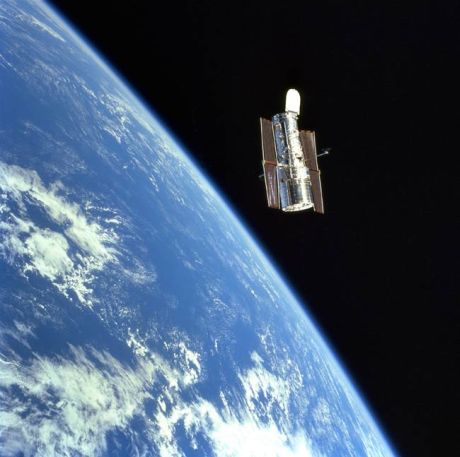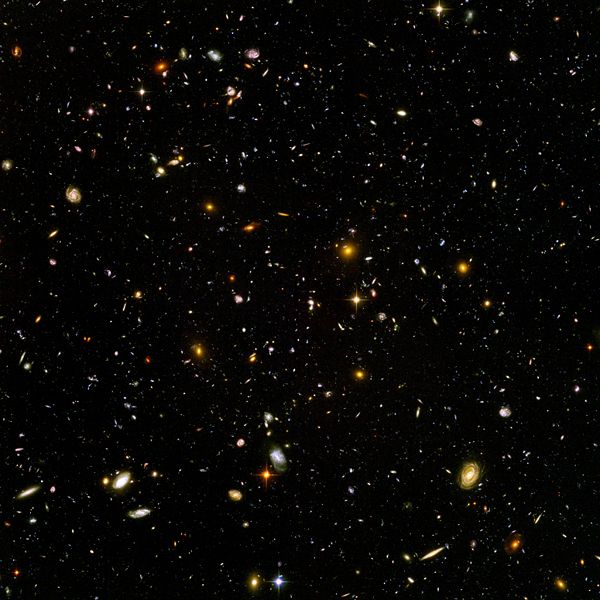1990 – Today: Hubble Space Telescope

The Hubble Space Telescope (HST) is a the first large space telescope in orbit around the Earth, named after astronomer Edwin Hubble. Its position outside the Earth’s atmosphere provides significant advantages over ground-based telescopes — images are not blurred by the atmosphere, there is no background from light scattered by the air, and the Hubble can observe ultraviolet light that is normally absorbed by the ozone layer in observations made from Earth. Since its launch in 1990, it has become one of the most important instruments in the history of astronomy. With it, astronomers have made many observations leading to breakthroughs in astrophysics. Hubble’s Ultra Deep Field has the most detailed visible light image of the most distant objects ever taken.
The construction and launch of the Hubble was beset by delays and budget problems. Then, soon after its 1990 launch, it was found that the main mirror suffered from spherical aberration due to faulty quality control during its manufacturing, severely compromising the telescope’s capabilities. However, after a servicing mission in 1993, the telescope was restored to its intended quality and became a vital research tool as well as a public relations boon for astronomy. The HST is part of NASA’s Great Observatories series, with the Compton Gamma Ray Observatory, the Chandra X-ray Observatory, and the Spitzer Space Telescope. Hubble is a collaboration between NASA and the European Space Agency.

The Hubble Space Telescope (HST) is a the first large space telescope in orbit around the Earth, named after astronomer Edwin Hubble. Its position outside the Earth’s atmosphere provides significant advantages over ground-based telescopes — images are not blurred by the atmosphere, there is no background from light scattered by the air, and the Hubble can observe ultraviolet light that is normally absorbed by the ozone layer in observations made from Earth. Since its launch in 1990, it has become one of the most important instruments in the history of astronomy. With it, astronomers have made many observations leading to breakthroughs in astrophysics. Hubble’s Ultra Deep Field has the most detailed visible light image of the most distant objects ever taken.
The construction and launch of the Hubble was beset by delays and budget problems. Then, soon after its 1990 launch, it was found that the main mirror suffered from spherical aberration due to faulty quality control during its manufacturing, severely compromising the telescope’s capabilities. However, after a servicing mission in 1993, the telescope was restored to its intended quality and became a vital research tool as well as a public relations boon for astronomy. The HST is part of NASA’s Great Observatories series, with the Compton Gamma Ray Observatory, the Chandra X-ray Observatory, and the Spitzer Space Telescope. Hubble is a collaboration between NASA and the European Space Agency.

Improvement in Hubble images after servicing.
The two instruments that have failed are the Space Telescope Imaging Spectrograph (STIS) which stopped working in August 2004 and the Advanced Camera for Surveys (ACS) which ceased operations in January 2007 (operations were later restored for its little used far-ultraviolet mode). Currently (mid-2007) Hubble observations are being taken with the Wide Field and Planetary Camera 2 (WFPC2) and the Near Infrared Camera and Multi-Object Spectrometer (NICMOS). Astrometry is being carried out with the Fine Guidance Sensor (FGS). Without a reboost to increase the diameter of its orbit, drag will cause Hubble to re-enter the Earth’s atmosphere sometime after 2010.
Following the 2003 Columbia Space Shuttle disaster, the fifth servicing mission (SM4), initially planned for 2004, was canceled on safety grounds. NASA determined that a manned mission would be too dangerous, due to a lack of access to the International Space Station (ISS), which can serve as a safe haven for an astronaut crew. The Shuttle cannot travel between the Hubble and ISS orbits. The organization later reconsidered this position, and, on October 31, 2006, NASA administrator Mike Griffin gave the green light for a final Hubble servicing mission to be flown by Atlantis. The mission is now planned for August 2008. As a safety precaution, NASA will have the orbiter Endeavour standing by at Launch Complex 39B to provide rescue in the event of an emergency. The planned repairs to the Hubble will allow the telescope to function until at least 2013, when its successor, the James Webb Space Telescope (JWST), is due to be launched. The JWST will be far superior to Hubble for many astronomical research programs, but will only observe in infrared, so it will not replace Hubble’s ability to observe in the visible and ultraviolet parts of the spectrum.

The Hubble Ultra Deep Field, or HUDF, is an image of a small region of space in the constellation Fornax, composited from Hubble Space Telescope data accumulated over a period from September 3, 2003 through January 16, 2004. It is the deepest image of the universe ever taken in visible light, looking back in time more than 13 billion years. The HUDF contains an estimated 10,000 galaxies. The patch of sky in which the galaxies reside (just one-tenth the diameter of the full moon as viewed from Earth) was chosen because it had a low density of bright stars in the near-field. Although most of the targets visible in the Hubble image can also be seen at infrared wavelengths by ground-based telescopes, Hubble is the only instrument which can make observations of these distant targets at visible wavelengths.
Shortened article from Hubble Space Telescope – Wikilpedia. Published under the terms of the GNU Free Documentation License, Version 1.2.
